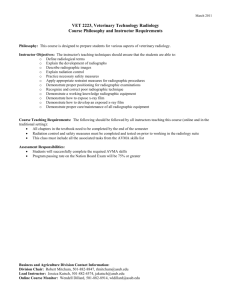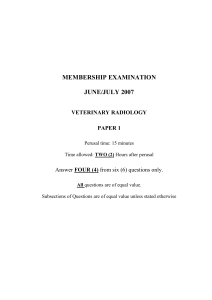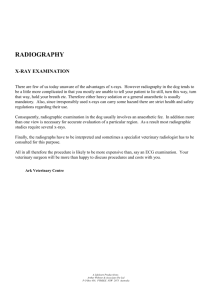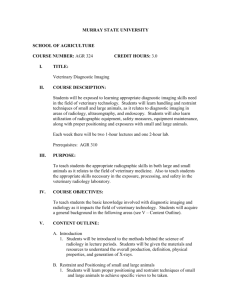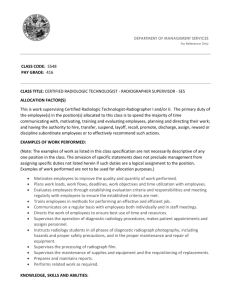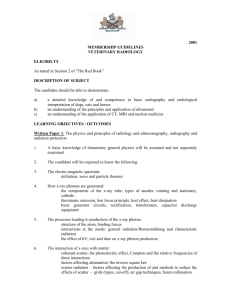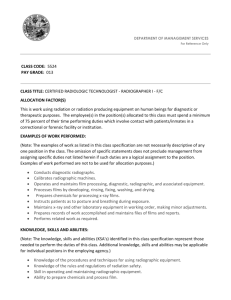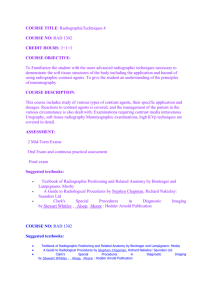Veterinary Radiology - Australian College of Veterinary Scientists
advertisement
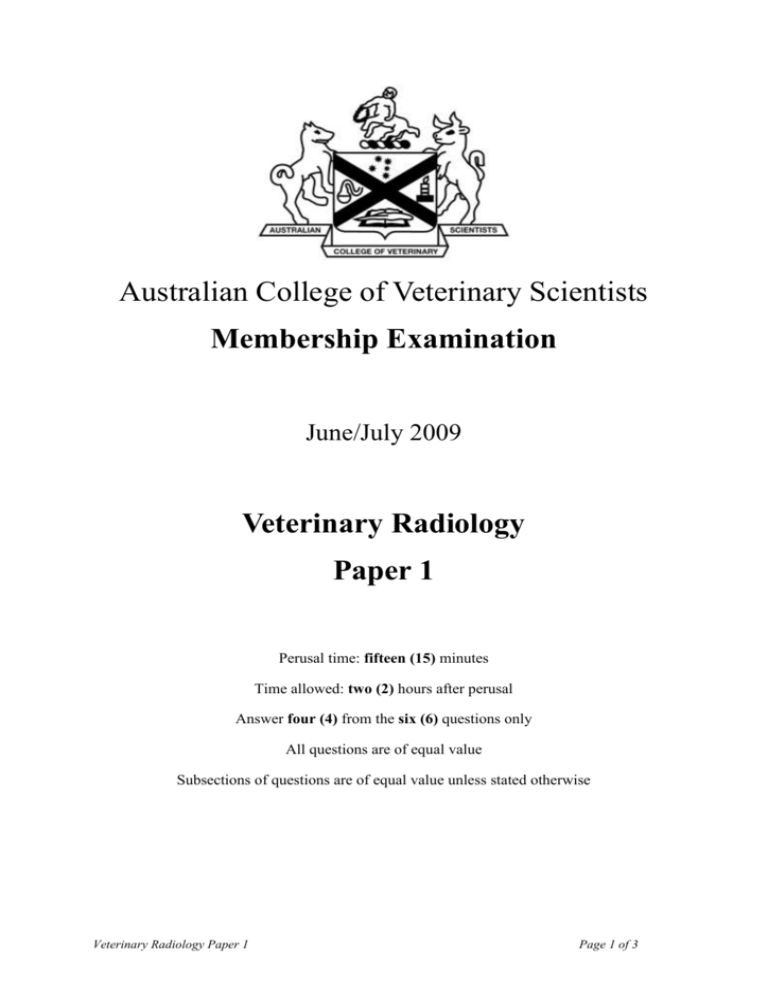
Australian College of Veterinary Scientists Membership Examination June/July 2009 Veterinary Radiology Paper 1 Perusal time: fifteen (15) minutes Time allowed: two (2) hours after perusal Answer four (4) from the six (6) questions only All questions are of equal value Subsections of questions are of equal value unless stated otherwise Veterinary Radiology Paper 1 Page 1 of 3 Paper 1: Veterinary radiology Answer four (4) from the six (6) questions only. 1. Describe in detail how you would adhere to the principles of radiation safety and the Australia/New Zealand Radiation Safety Regulations when obtaining radiographs of the carpus of a horse in a client’s stable. 2. Answer both of the following: a) Discuss the factors that affect axial and lateral resolution in diagnostic ultrasound. b) What factors do you need to consider when selecting which transducer(s) to scan an abdomen? 3. Scatter radiation reduces radiographic quality. Answer both of the following: a) How is scatter radiation produced, and what factors affect the quantity of scatter radiation produced? b) What steps can be taken to minimise the effects of scatter radiation on the image? 4. Describe your positioning and radiographic technique for obtaining each of the following radiographic projections. In each answer, include the features on the radiographic image that you check to ensure you have achieved ideal positioning: a) extended leg ventrodorsal projection of the hips of a two-year-old Labrador for AVA hip scoring (not PennHIP) b) lateral thorax of a poodle c) dorsopalmar projection of the fetlock of a thoroughbred d) craniolateral–caudomedial oblique of the elbow of a German shepherd dog. Continued over page Veterinary Radiology Paper 1 Page 2 of 3 5. Film underdevelopment is a common cause of reduced radiographic quality. Answer both the following: a) Describe the effect of underdevelopment on the radiographic image, and how you would distinguish it from underexposure. b) Outline the causes of film underdevelopment and the steps you would take to remedy them. 6. Write notes on all of the following: a) intensifying screen speed b) refraction artefact in ultrasound c) line focus principle d) distance enhancement (through transmission) in ultrasound. End of paper Veterinary Radiology Paper 1 Page 3 of 3 Australian College of Veterinary Scientists Membership Examination June/July 2009 Veterinary Radiology Paper 2 Perusal time: fifteen (15) minutes Time allowed: two (2) hours after perusal Answer four (4) from the six (6) questions only All questions are of equal value Subsections of questions are of equal value unless stated otherwise Veterinary Radiology Paper 2 Page 1 of 3 Paper 2: Veterinary radiology Answer four (4) from the six (6) questions only. 1. Write notes on the radiographic appearance of all of the following conditions: a) discospondylitis in a German shepherd dog b) cranial mediastinal mass in a cat c) nasal adenocarcinoma in a dog d) sesamoiditis in a horse. 2. Answer both of the following: a) You are presented with a 10-year-old corgi with a worsening cough and dyspnoea. Auscultation of the thorax reveals a grade 2/6 left-sided heart murmur, harsh respiratory sounds and some crackles. You obtain DV and left and right lateral radiographs of the thorax. Describe in detail how you would differentiate left-sided congestive heart failure from pneumonia using the radiographs of this patient. b) Compare and contrast the radiographic appearance of gastric dilation versus gastric dilation and volvulus. 3. A five-year-old Labrador presents to you with vomiting of 24 hours’ duration. You suspect a small intestinal obstruction and radiograph the abdomen to determine whether to go to surgery or not. Answer both of the following: a) List the radiographic rules and signs that may be used to determine whether a complete small intestinal obstruction is present. b) Describe how you could use imaging to further investigate this case. 4. Write notes on the radiographic appearance of each the following conditions: a) polycystic kidney disease in a Persian cat b) elbow dysplasia in a six-month-old rottweiler c) feline asthma d) osteochondritis dissecans of the equine stifle. Continued over page Veterinary Radiology Paper 2 Page 2 of 3 5. Answer both of the following: a) You repair a compound, comminuted, diaphyseal tibial and fibular fracture in a four-year-old kelpie with an external fixateur. At the six-week revisit, there is heat and swelling around the pins and the dog is lame. Describe the expected radiographic appearance of healing of this type of fracture at this time. What radiographic signs would enable you to distinguish between pin loosening and osteomyelitis? b) You examine a Shetland pony suffering acute bilateral forelimb lameness with heat and bounding digital pulses in the forefeet. What radiographic projections would you obtain of this patient and what radiographic signs do you expect to encounter? 6. Answer both of the following: a) Discuss ionic and non-ionic iodinated contrast agents, their uses and contraindications in veterinary diagnostic imaging. Give an example of each. b) Describe in detail how you would perform a double contrast cystogram in a bitch with suspected transitional cell carcinoma. End of paper Veterinary Radiology Paper 2 Page 3 of 3
